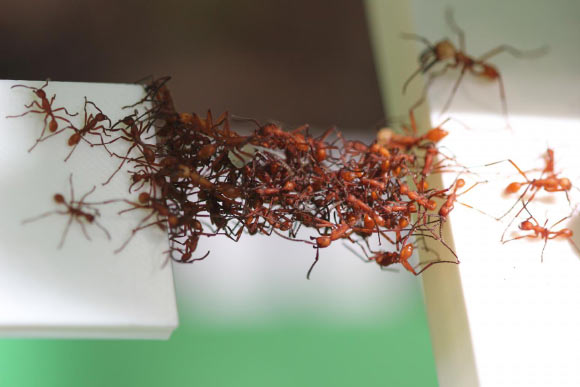A group of entomologists led by Dr Christopher Reid of the University of Sydney has discovered complex bridges constructed by Eciton army ants with their own bodies can move from original building point, changing position as required.
Dr Reid and co-authors examined ‘bridges’ of linked individuals that are constructed to span gaps in the colony’s foraging trail.
The team found that the ant bridges can assemble and disassemble in seconds, and can change their position in response to the immediate environment.
“The bridges stop moving when they become so long that the increasing costs incurred by locking workers into the structure outweigh the benefit that the colony gains from further shortening their trail,” the scientists said.
“Bridges dismantle when the ants in the structure sense the traffic walking over them slows down below a critical threshold.”
The dynamic nature of the ant bridges has been found to facilitate travel by the colony at maximum speed, across unknown and potentially dangerous terrains.
Prior to this study it was assumed that, once they had been built, the bridges were relatively static structures.

Army ants form collective assemblages out of their bodies to perform a variety of functions that benefit the entire colony. Image credit: Chris R. Reid.
“Indeed, after starting at intersections between twigs or lianas traveled by the ants, the bridges slowly move away from their starting point, creating shortcuts and progressively lengthening by addition of new workers, before stopping, suspended in mid-air,” explained Dr Reid, who is the first author of a paper in the journal Proceedings of the National Academy of Sciences.
“In many cases, the ants could have created better shortcuts, but instead they ceased moving their bridges before achieving the shortest route possible.”
Dr Reid and his colleagues discovered that, although army ants benefited from shorter traveling distances because of their bridges, they also incurred a cost by sequestering workers that could be used for other important tasks. When building their bridges, army ants had to balance this cost-benefit trade-off.
“We show that bridge location represents a cost-benefit trade-off, with potential implications for human engineered self-assembling systems,” the researchers said.
_____
Chris R. Reid et al. Army ants dynamically adjust living bridges in response to a cost-benefit trade-off. PNAS, published online November 23, 2015; doi: 10.1073/pnas.1512241112







